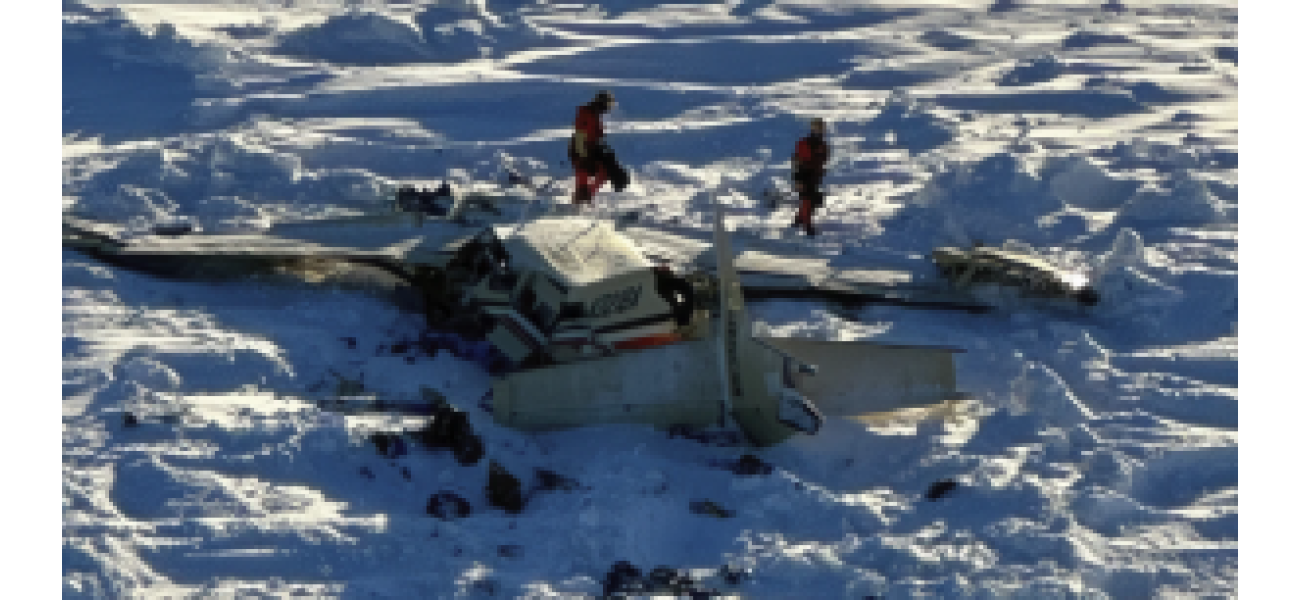A small plane, with 10 people on board, has been discovered crashed in western Alaska, resulting in the death of all passengers.
A small plane crashed in western Alaska on its way to Nome, killing all 10 people on board. Rescue efforts were underway.
February 8th 2025.

Tragedy struck in western Alaska as a small commuter plane, carrying 10 people on board, crashed on its way to the hub community of Nome. The devastating news was confirmed by Mike Salerno, a spokesperson for the US Coast Guard, who shared that the wreckage was located on sea ice on Friday.
According to Salerno, rescuers were searching the last known location of the aircraft by helicopter when they spotted the wreckage. In an effort to investigate, two rescue swimmers were lowered down. The Bering Air single-engine turboprop plane had departed from Unalakleet on Thursday afternoon with nine passengers and a pilot, as reported by Alaska's Department of Public Safety.
David Olson, the director of operations for Bering Air, revealed that the Cessna Caravan had taken off at 2:37 pm and officials had lost contact with it less than an hour later. The National Weather Service reported light snow and fog with a temperature of 17 degrees at the time of the incident.
The Coast Guard released a statement saying that the plane had gone missing about 30 miles southeast of Nome. It was later discovered that the aircraft was 12 miles offshore, according to the Coast Guard. The airline had confirmed that the plane was operating at maximum passenger capacity.
Further details were revealed by Coast Guard Lt. Cmdr. Benjamin McIntyre-Coble, who stated that radar forensic data provided by the U.S. Civil Air Patrol indicated that at around 3:18 pm on Thursday, the plane had experienced "some kind of event" which caused a rapid loss of elevation and speed. However, McIntyre-Coble refrained from speculating on the exact nature of the event.
Despite extensive search efforts, there were no distress signals from the aircraft. Lt. Ben Endres of the Alaska State Troopers shared that all 10 people on board were adults and the flight was a regularly scheduled commuter trip. This unfortunate incident marks the third major U.S. aviation mishap in just eight days.
Alaska's remote communities often rely on airplanes for travel, particularly during the harsh winter months when roads are not accessible. However, the region is known for its sudden snow squalls and high winds, making it challenging for search parties to operate safely.
Bering Air, which serves 32 villages in western Alaska from hubs in Nome, Kotzebue, and Unalakleet, had two planes searching in a grid pattern near the coastline on Friday morning. The flight tracking service Flightradar24 reported their efforts.
The search effort was a collaborative one, with local, state, and federal agencies joining in. They scoured miles of frozen tundra and flew over stretches of ice-dotted waters. The National Guard was approved to fly a helicopter, and the Coast Guard also deployed aerial search efforts.
In a bid to track the movement of sea ice, the Coast Guard planned to drop a buoy, and a ground crew on snowmobiles were dispatched to cover the coast and surrounding areas. Unalakleet, the community where the plane departed from, is located about 150 miles southeast of Nome and 395 miles northwest of Anchorage. The village sits on the Iditarod trail, the route of the world's most famous sled dog race.
The city of Nome, which is just south of the Arctic Circle and known as the ending point of the 1,000-mile Iditarod, announced that prayer vigils would be held for the passengers, their families, and those involved in the search efforts. Alaska's US senators, Lisa Murkowski and Dan Sullivan, expressed their sympathies and offered their prayers for the passengers, their families, and the Nome community.
U.S. Rep. Nick Begich also took to social media to express his readiness to assist Nome and Alaska Governor. This tragedy has deeply affected the entire community, and our hearts go out to all those impacted by this devastating event.
According to Salerno, rescuers were searching the last known location of the aircraft by helicopter when they spotted the wreckage. In an effort to investigate, two rescue swimmers were lowered down. The Bering Air single-engine turboprop plane had departed from Unalakleet on Thursday afternoon with nine passengers and a pilot, as reported by Alaska's Department of Public Safety.
David Olson, the director of operations for Bering Air, revealed that the Cessna Caravan had taken off at 2:37 pm and officials had lost contact with it less than an hour later. The National Weather Service reported light snow and fog with a temperature of 17 degrees at the time of the incident.
The Coast Guard released a statement saying that the plane had gone missing about 30 miles southeast of Nome. It was later discovered that the aircraft was 12 miles offshore, according to the Coast Guard. The airline had confirmed that the plane was operating at maximum passenger capacity.
Further details were revealed by Coast Guard Lt. Cmdr. Benjamin McIntyre-Coble, who stated that radar forensic data provided by the U.S. Civil Air Patrol indicated that at around 3:18 pm on Thursday, the plane had experienced "some kind of event" which caused a rapid loss of elevation and speed. However, McIntyre-Coble refrained from speculating on the exact nature of the event.
Despite extensive search efforts, there were no distress signals from the aircraft. Lt. Ben Endres of the Alaska State Troopers shared that all 10 people on board were adults and the flight was a regularly scheduled commuter trip. This unfortunate incident marks the third major U.S. aviation mishap in just eight days.
Alaska's remote communities often rely on airplanes for travel, particularly during the harsh winter months when roads are not accessible. However, the region is known for its sudden snow squalls and high winds, making it challenging for search parties to operate safely.
Bering Air, which serves 32 villages in western Alaska from hubs in Nome, Kotzebue, and Unalakleet, had two planes searching in a grid pattern near the coastline on Friday morning. The flight tracking service Flightradar24 reported their efforts.
The search effort was a collaborative one, with local, state, and federal agencies joining in. They scoured miles of frozen tundra and flew over stretches of ice-dotted waters. The National Guard was approved to fly a helicopter, and the Coast Guard also deployed aerial search efforts.
In a bid to track the movement of sea ice, the Coast Guard planned to drop a buoy, and a ground crew on snowmobiles were dispatched to cover the coast and surrounding areas. Unalakleet, the community where the plane departed from, is located about 150 miles southeast of Nome and 395 miles northwest of Anchorage. The village sits on the Iditarod trail, the route of the world's most famous sled dog race.
The city of Nome, which is just south of the Arctic Circle and known as the ending point of the 1,000-mile Iditarod, announced that prayer vigils would be held for the passengers, their families, and those involved in the search efforts. Alaska's US senators, Lisa Murkowski and Dan Sullivan, expressed their sympathies and offered their prayers for the passengers, their families, and the Nome community.
U.S. Rep. Nick Begich also took to social media to express his readiness to assist Nome and Alaska Governor. This tragedy has deeply affected the entire community, and our hearts go out to all those impacted by this devastating event.
[This article has been trending online recently and has been generated with AI. Your feed is customized.]
[Generative AI is experimental.]
0
0
Submit Comment





